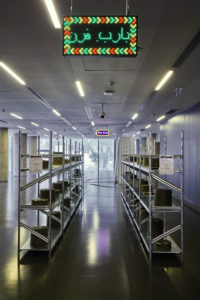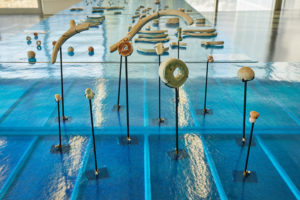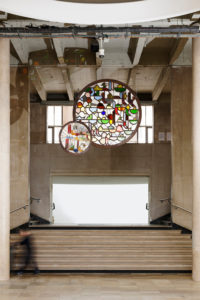Prix AWARE
© Photo: Antoine Aphesbero
Sara Ouhaddou is a maker of complex objects. She says that she has created them for as long as she can remember – in the South of France where she was born, as well as in Meknes, Morocco, where her grandparents lived.
She made do with what she had on hand – scraps of fabric and wood from tailors and carpenters on the street near her family home, belongings of those close to her – to create elaborate toys. Later she studied design in France but more importantly returned to Morocco as often as possible to conduct research with her aunts who were all craftswomen. Each one had their own specialty: weaving, sewing, embroidering, cooking. Her very first artistic collaboration, according to the artist, was with her family.

Sara Ouhaddou, Je te rends ce qui m’appartient / Tu me rends ce qui t’appartient [I Give You Back What’s Mine / You Give Me Back What’s Yours], 2020, archives shelves, ceramic, soap, folding tables, Commissioned by Manifesta 13 Marseille, © Photo: Jean Christophe-Lett, © Sara Ouhaddou

Sara Ouhaddou, Je te rends ce qui m’appartient / Tu me rends ce qui t’appartient [I Give You Back What’s Mine / You Give Me Back What’s Yours], 2020, archives shelves, ceramic, soap, folding tables, Commissioned by Manifesta 13 Marseille, © Photo: Jean Christophe-Lett, © Sara Ouhaddou
From this relationship arose a production and discourse on forms, their return and their power as well as their history in all of its political and economic dimensions. Her working methods thus almost always include a third party, a professional craftsperson. It is a collaborative work carried out in the working space of the artisan. The works produced are tapestries, ceramics, jewellery, stained-glass, new alphabets, as well as artefacts that mimic the vestiges found in museums. These works as almost always shared in the form of installation and are the fruit of months of work. This long period of time is an important factor in the process of S. Ouhaddou. She describes observing an event, most often in her own family, documenting it, “classifying” it. Then, much later, while observing an artisan, a form or something reminds her of this event. When these two instants merge, the work begins and is derived from a succession of visual and sensitive experiences. S. Ouhaddou then works on all possible content in the situation: the objects travel and transform, and with the artisans she develops a series of inexpensive articles that are easy to sell outside of the artistic collaboration that united them. The revenue from these sales goes directly to the artisans. As the artist explains, it is always about sharing the perception of their work; the frustrations; the devaluation of an exploited production and on what these increasingly exploitable producers experience; and the contempt of a creation perceived as subject to tourism.

Sara Ouhaddou, Sin Ithran, Ur Mqadan, Rousn [Deux Astres, Aux déséquilibre, se brûlent], 2019, stained glass window of recycled glass, brass and cedar wood, © Photo: Say Who, © Sara Ouhaddou
The intuitions that craft the work of S. Ouhaddou have a historical foundation. While I was writing this text and talking with the artist about the exhibition Jeux de mémoires. Ahmed Bouanani aujourd’hui, the curator Omar Berrada published a quote and a homage to late artist, author and curator Marion von Osten.1 She explained that Moroccan handicraft production has played a major role in an already global economy for centuries. It has never corresponded to the repetitive aesthetic canon that the history of French art wanted to identify thereafter. Craft was one of the first fields in which the French protectorate of Morocco intervened. New products were introduced, commercial relations were modified. Essentially, the classification and perception of the objects produced were disrupted. The interventions by French officials transformed these goods – simultaneously every day and inscribed in global economic circuits – into traditional objects: the “cultural production” of a pre-modern local economy, a patrimony to preserve. Double destruction: on the one hand, a local economy was devalued while supposedly being protected; on the other, the new status of decorative accessory was imposed on the artifacts as opposed to the true object, a unique object of value, the consumer good resulting from industrialisation.2 These words echoed the reflections we shared, and with such accuracy.

Sara Ouhaddou, Woven//Unwoven, 2013/2018, embroidery on recycled rubber, © Photo: Rebecca Fanuele, © Sara Ouhaddou
S. Ouhaddou’s work is inspired by spiritual practices, intuitive imaginations and research on the profound issues of “tradition”. It is a work on the continuities of creation on a global scale; in 2017, the artist produced a piece for the city of New York, a public commission dedicated to the history of the Little Syria neighbourhood. Today she is concerned with “object histories” between Japan and Morocco.
Eva Barois De Caevel
Sara Ouhaddou (born 1986 in Draguignan, France) mainly realises installations in collaboration with craftsmen and women. The double culture of Sara Ouhaddou, born in France to a Moroccan family, shapes her artistic practice as a continuous language. She studied at the Ecole Olivier de Serres in Paris. She questions the transformation of her heritage while confronting traditional Moroccan arts with the codes of contemporary art in order to highlight and put the forgotten cultural continuities of creation into perspective.
Jeux de mémoires. Ahmed Bouanani with works by Sara Ouhaddou, Mohssin Harraki and Yto Barrada, “Not New Now”, 6th Marrakech Biennale, Palais El Bahia, February–March 2016. Omar Berrada is a writer, critic, translator and curator.
2
These reflections come from the interview between Kader Attia and Marion von Osten published in Marion von Osten: Once We Were Artists (A BAK Critical Reader in Artists’ Practice), eds Maria Hla-vajova and Tom Holert, Utrecht, BAK – basis voor aktuele kunst/Amsterdam, Valiz, 2017.
Translated from French by Katia Porro.
Tous droits réservés dans tous pays/All rights reserved for all countries.





